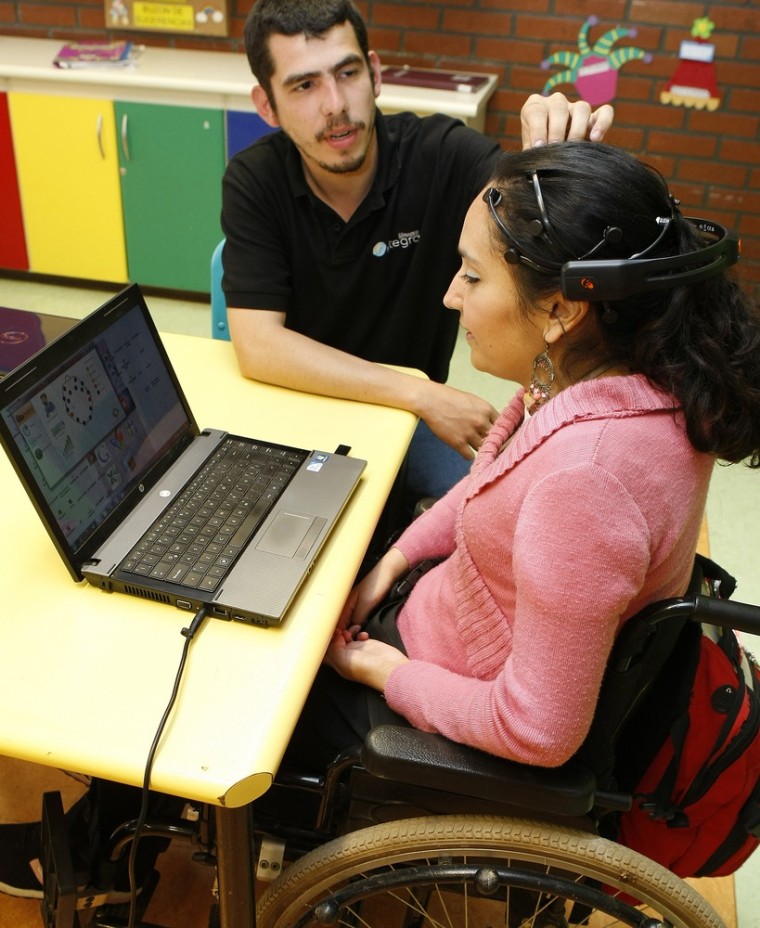Several recent reports tell a troubling story about Americans with disabilities: While many would have no trouble using the Internet, a large percentage lack access to it in the home.
Consider these contrasting numbers: 54 percent of American adults with disabilities use the Internet, compared with 81 percent of those who do not claim to have a disability, according to a report released this morning by the Pew Research Center. Both the Pew study and another conducted last fall by the National Telecommunications and Information Administration (available here in PDF form), show that the problem starts at home.
"Households headed by someone with a disability were almost half as likely as households headed by someone with no disability to have broadband Internet," says the NTIA report.
Yet the percentage of Americans who feel their disabilities keep them from going online is smaller. According to Pew, 2 percent of the overall population, less than 10 percent of the overall disabled population, say their affliction "makes it harder or impossible for them to use the Internet."
The studies show that there are two separate factors that digitally divide Americans with disabilities from their non-disabled counterparts. While accessibility of online content is a serious issue, the larger problem is getting Internet service at home. In most cases, this comes down to economics.
"People with disabilities ... were older, with an average age of 63, compared to 48 among householders with no disability," said the NTIA report. "People with disabilities also had lower levels of household income and obtained less education. Almost half of all householders with disabilities (45 percent) had family incomes less than $25,000, compared to a fifth (19 percent) of the population with no disability."
The reasons are varied, said William Stothers, deputy director of the The Center for an Accessible Society. Not only can working be a problem, there is still a lot of discrimination in the workforce against disabled people who may be perceived to need more "help." And many face a similar challenge in getting quality education.
"Even when [disabled people] go through college, employment levels tend to be lagging behind the general population," said Stothers. In some cases they're even dissuaded from joining the workforce for fear of losing government-funded aid.
But disabled Americans who do not face economic hardships do tend to access the Internet. "If they have the technology and access, then most of the people can use it," said Stothers.
Several major government initiatives are focused on closing the economic gap, most particularly the Federal Communications Commission's National Broadband Plan, which works with telecoms to roll out network coverage to areas where it's unavailable, and to offer acceptable prices to lower-income homes.
During a recent media appearance in Washington, FCC Chairman Julius Genachowski remarked on his plan's recent progress. "For approximately 2.5 million low-income households," he said, "Comcast will make available high-speed Internet for less than $10 a month, plus personal computers, netbooks or other computer equipment at a price of less than $150."
(Msnbc.com is a joint venture of Microsoft and NBC Universal, which is currently being acquired by Comcast.)
Meanwhile, the NTIA is administering billions of dollars in grant money from the American Recovery and Reinvestment Act and the Broadband Technology Opportunities Program. While funding covers efforts to bridge the greater digital divide, some money is earmarked specifically for programs to help provide Internet access to people with disabilities. Efforts involve providing discounted broadband and computers to people who are deaf or hard of hearing, outfitting human-services facilities with the express intention of increasing broadband access for disabled people, and upgrading libraries and other public facilities to enhance broadband access for the disabled.
Accessibility matters
But just because the primary barrier to Internet access for disabled Americans appears to be the lack of broadband at home, it's important to recognize that millions of people — 2 percent of the entire online population, according to Pew — still struggle once the connection is made.
For most, it's a visual or learning impairment that makes on-screen text difficult or impossible to read. For others, it's hearing issues that require better closed-captioning on Web video and other audible content. But for all of these Americans, it's a frustration. Alexandra Enders, senior policy analyst at the Rural Institute at the University of Montana, likens it to a language barrier.
"If you don't read Russian and all the sites are in Russian, you may be able to get to them, but they won't make sense to you," she said.
Recently, the U.S. government addressed this problem head-on. Congress passed the 21st Century Communications and Video Accessibility Act, which President Barack Obama signed into law on Oct. 10. Obama said the act will "make it easier for people who are deaf, blind or live with a visual impairment to do what many of us take for granted — from navigating a TV or DVD menu to sending an email on a smart phone."
The act is intended to help Americans with disabilities "take advantage of the technology our economy depends on," said Obama. "And that’s especially important in today’s economy, when every worker needs the necessary skills to compete for the jobs of the future."
But Enders argues that this problem shouldn't simply be considered something for government to solve. Several million Americans in need constitutes a market that should be addressed by large businesses and socially conscious entrepreneurs. She cites Jim Fruchterman, president of Benetech. The revenue-driven non-profit built Bookshare for readers with visual and learning disabilities, and is currently moving into more challenging area of "image accessibility" — that is, interpreting graphical representations for people who can't see them.
"You can definitely make a business case for this," Enders said.
